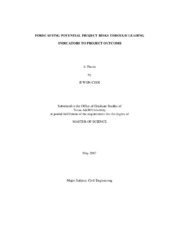| dc.description.abstract | During project execution, the status of the project is periodically evaluated, using
traditional methods or standard practices. However, these traditional methods or
standard practices may not adequately identify certain issues, such as lack of sufficient
identification of warning signs that predict potential project failure. Current methods
may lack the ability to provide real time indications of emerging problems that impact
project outcomes in a timely manner.
To address this problem, the Construction Industry Institute (CII) formed a
research team to develop a new tool that can forecast the potential risk of not meeting
specific project outcomes based on assessing leading indicators. Thus, the leading
indicators were identified and then the new tool was developed and validated.
A screening process was conducted through industry surveys after identifying
potential leading indicators. Each time, industry professionals were asked to evaluate
the negative impact of leading indicators on project outcomes that were identified to
measure the impact of leading indicators on project health. Through this process, forty-three leading indicators were acquired finally. Using descriptive statistics, the amount of
negative impact of each leading indicator on project outcomes was identified after the
analysis of the survey results. Based on these impacts, the tool development was
initiated.
The tool concept is that no indication of problems based on assessing leading
indicators results in the tool output score high. To comply with this concept, specific
weights were assigned to each leading indicator to reflect the impact on each project
outcome. By this procedure, the Project Health Indicator (PHI) tool was developed. The
validation process of the PHI tool was conducted using completed projects and finally
negative correlation was observed between project outcomes and health scores generated
by the PHI tool. | en |


